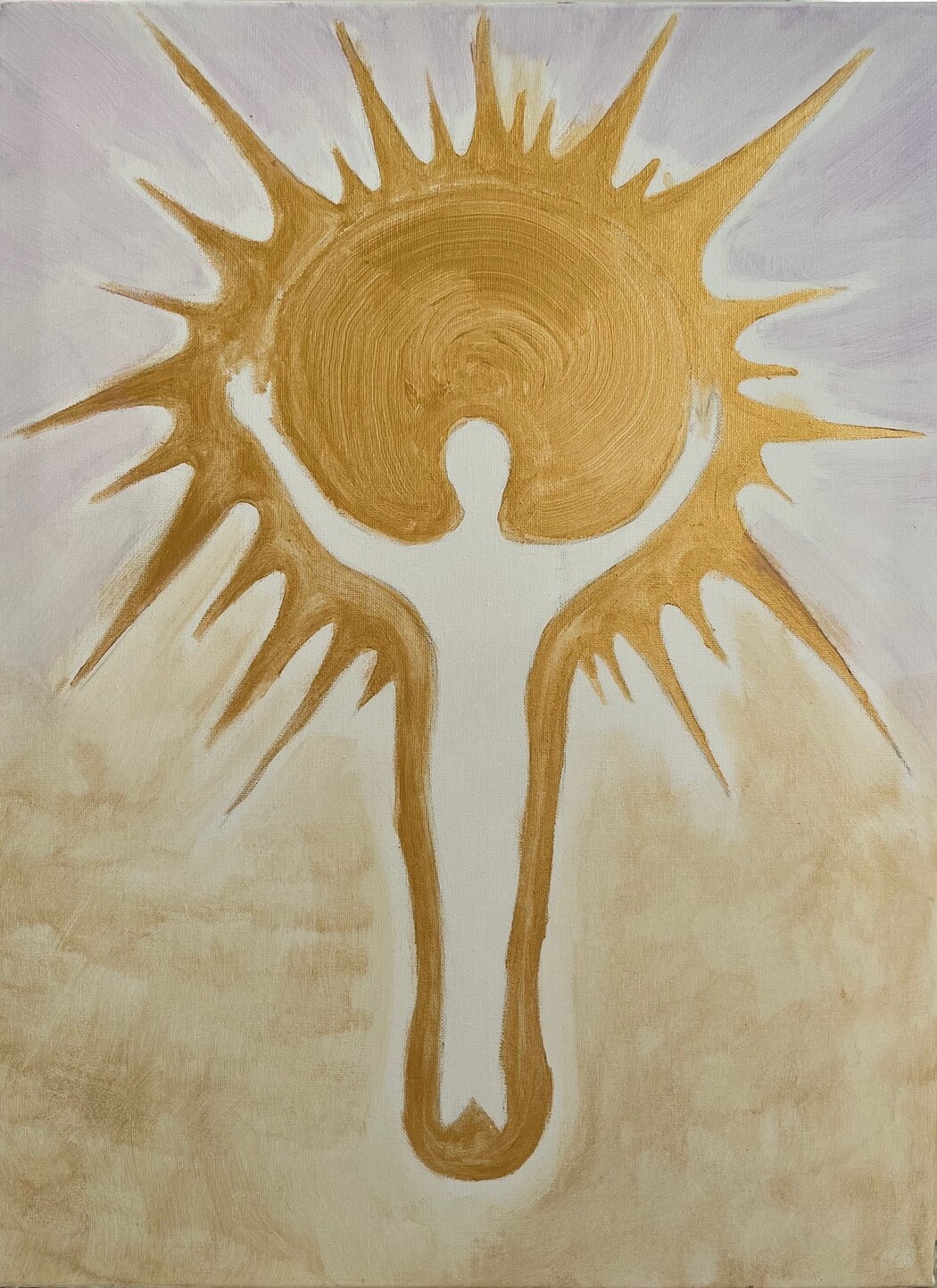Ana Hazelny
Year of birth: 1994.
Where do you live: Limburg, The Netherlands.
Your education: BA in Art and Design Theory (2015, Budapest), Postgraduate Certificate in Complex Art Therapy (2021, Budapest).
Describe your art in three words: dreamy, spiritual, ethereal.
Instagram
Could you tell us about the inner vision that inspired The Golden Hug?
In The Golden Hug, I captured a personal spiritual experience—a moment of being filled with the presence of God, when the soul resonates with the pure joy of existence. If I were to put it into words, it would be like standing in sunlight and getting a hug from it: a warmth that surrounds you inside and out, filling your heart with hope and love for all that is.
How does spirituality influence your creative process?
Growing up as the daughter of a psychologist gave me an early awareness that there is more to life than just the physical world. For as long as I can remember, I’ve been drawn to spirituality, different religions, and philosophy—anything that seeks to answer the deeper questions about the meaning of life. I read and learn extensively about these topics, which is a great source of inspiration for my art. Certain thoughts or ideas leave a strong impression on me—they may later transform into inner images or pop up in my works in some form. In many ways, my art reflects what my mind is currently processing on my spiritual journey.
What role do dreams play in your artistic expression?
Dreams play a central role in my artistic expression, as many of my works depict scenes I’ve seen in dreams. They are a core part of my creative process. I’ve had a vivid dream life since childhood, and from an early age, I’ve kept journals and reflected on them—gradually developing a strong symbolic language that also shaped my art. For me, the dream state feels almost as real as waking life: a unique state of mind where the soul can play freely and channel messages the conscious mind might not otherwise hear. I see dreams as a powerful tool for self-reflection and personal growth—if we are willing to listen and understand them.
You combine aquarelle and acrylics with fine line work—what draws you to this combination?
I enjoy experimenting with different techniques, as each evokes something unique in me. Acrylics feel like a heavier, more grounded material to work with, while watercolor has an ethereal, fluid quality. Both are challenging to control and often require broader, more expressive movements. On the other hand, fine lines allow me to add precise finishing touches when I feel a piece needs more detail. They help create a balance between boldness and softness, the infinite and the structured.
 Ana Hazelny | The golden hug | 2025
Ana Hazelny | The golden hug | 2025
How has your background in complex art therapy influenced your artwork?
Art therapy has helped me to let go of my inner critic. In this space, creating isn’t about the final product—it’s about the process. There is no right or wrong way to do it; the point is to allow the soul to express itself freely. Every movement, color, and form carry its own meaning, offering a reflection of one’s current inner world. This is also how I approach my own creative process. I let the picture unfold naturally, allowing my emotions to flow without restriction. Art therapy has deepened my understanding of art as a tool for healing and transformation. Through participating in and leading numerous art therapy workshops, I’ve been able to uncover my authentic artistic voice and connect with my unique soul-language. It’s guided me toward the importance of authenticity rather than aesthetics.
Do you see your art as a form of healing or transformation—for yourself or for the viewer?
Absolutely—creating is a deeply healing process for me. When I transform inner images, emotions, and dreams into art, it becomes a powerful tool for self-reflection and personal growth. Art allows what lies in the unconscious to be brought into the light of conscious awareness, where it can be seen, processed, and released. I always create in a flow state, fully immersed in the here and now. This presence is profoundly healing—especially in a world where our minds are constantly scattered and distracted.
That’s why it can also be meaningful for the viewer—to be momentarily taken out of the rush of daily life, allowing the mind to wander and awakening something universal within, even if only for a few seconds. Over the years, I’ve received feedback from people who were unexpectedly moved by my work—sometimes even to the point of tears.
How do your Hungarian roots and current life in the Netherlands influence your visual language?
Living in a different culture allows me to better understand my own roots by highlighting how my approach to life differs. At the same time, it enriches both my perspective and visual language. Through the lens of Dutch culture, I’ve become more aware of the uniqueness of my Eastern European identity and what it means to me. I find great inspiration in the hidden gems of Dutch architecture—like the stained-glass windows in churches and the small gevelbeelden (religious statues or images built into street-facing walls).


Leave a Reply